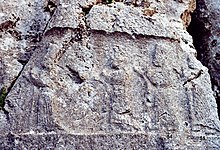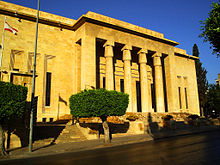THE PHOENICIA PORTAL

Phoenicia (/fəˈnɪʃə, fəˈniːʃə/), or Phœnicia, was an ancient Semitic thalassocratic civilization originating in the coastal strip of the Levant region of the eastern Mediterranean, primarily located in modern Lebanon. The territory of the Phoenicians expanded and contracted throughout history, with the core of their culture stretching from Arwad in modern Syria to Mount Carmel in modern Israel. Beyond their homeland, the Phoenicians extended through trade and colonization throughout the Mediterranean, from Cyprus to the Iberian Peninsula.
The Phoenicians directly succeeded the Bronze Age Canaanites, continuing their cultural traditions following the decline of most major cultures in the Late Bronze Age collapse and into the Iron Age without interruption. It is believed that they self-identified as Canaanites and referred to their land as Canaan, indicating a continuous cultural and geographical association. The name Phoenicia is an ancient Greek exonym that did not correspond precisely to a cohesive culture or society as it would have been understood natively. Therefore, the division between Canaanites and Phoenicians around 1200 BC is regarded as a modern and artificial division.
The Phoenicians, known for their prowess in trade, seafaring and navigation, dominated commerce across classical antiquity and developed an expansive maritime trade network lasting over a millennium. This network facilitated cultural exchanges among major cradles of civilization, such as Greece, Egypt, and Mesopotamia. The Phoenicians established colonies and trading posts across the Mediterranean; Carthage, a settlement in northwest Africa, became a major civilization in its own right in the seventh century BC.
The Phoenicians were organized in city-states, similar to those of ancient Greece, of which the most notable were Tyre, Sidon, and Byblos. Each city-state was politically independent, and there is no evidence the Phoenicians viewed themselves as a single nationality. While most city-states were governed by some form of kingship, merchant families probably exercised influence through oligarchies. After reaching its zenith in the ninth century BC, the Phoenician civilization in the eastern Mediterranean gradually declined due to external influences and conquests. Yet, their presence persisted in the central and western Mediterranean until the destruction of Carthage in the mid-second century BC. — Read more about Phoenicia, its mythology and language
 Featured article
•
Featured article
•
A Featured article represents some of the best content on Wikipedia
The Battle of Bagradas, the Bagradas, or the Bagradas River (the ancient name of the Medjerda) may refer to:
- Battle of the Bagradas River (255 BC), also known as the Battle of Tunis, during the First Punic War
- Battle of the Bagradas River (240 BC), also known as the Battle of the Macar, during the Mercenary War
- Battle of the Bagradas River (203 BC), usually known as the Battle of the Great Plains, during the Second Punic War
- Battle of the Bagradas River (49 BC), a battle during the Roman civil war between Caesar and Pompey
- Battle of the Bagradas River (536), a battle between the rebel leader Stotzas and Byzantine commander Belisarius (Full article...)
List of Featured articles
|
|---|
Phoenician mythology •
Images
 Good article
•
Good article
•
A Good article meets a core set of high editorial standards
The National Museum of Beirut (Arabic: متحف بيروت الوطنيّ, Matḥaf Bayrūt al-waṭanī) is the principal museum of archaeology in Lebanon. The collection begun after World War I, and the museum was officially opened in 1942. The museum has collections totaling about 100,000 objects, most of which are antiquities and medieval finds from excavations undertaken by the Directorate General of Antiquities.
During the 1975 Lebanese Civil War, the museum stood on the front line that separated the warring factions. The museum's Egyptian Revival building and its collection suffered extensive damage in the war, but most of the artifacts were saved by last-minute preemptive measures. (Full article...)Phoenician inscriptions & language •
The Ahiram sarcophagus (also spelled Ahirom, 𐤀𐤇𐤓𐤌 in Phoenician) was the sarcophagus of a Phoenician King of Byblos (c. 1000 BC), discovered in 1923 by the French excavator Pierre Montet in tomb V of the royal necropolis of Byblos.
The sarcophagus is famed for its bas relief carvings, and its Phoenician inscription. One of five known Byblian royal inscriptions, the inscription is considered to be the earliest known example of the fully developed Phoenician alphabet. The Phoenician alphabet is believed to be the parent alphabet for a wide number of the world's current writing systems; including the Greek, Latin and Cyrillic Alphabets, and the Hebrew, Arabic and Urdu Abjads. For some scholars it represents the terminus post quem of the transmission of the alphabet to Europe.
Ahirom is not attested in any other Ancient Oriental source, although some scholars [who?] have suggested a possible connection to the contemporary King Hiram mentioned in the Hebrew Bible (see Hiram I). (Full article...)Did you know (auto-generated) •

- ... that according to second-century AD Greek rhetorician Athenaeus, the Phoenicians played a flute-like instrument called the gingras in their mourning rituals?
- ... that Bochart's 1646 Geographia Sacra seu Phaleg et Canaan was the first full-length book devoted to the Phoenicians?
- ... that archaeological excavations in the historic town of Kharayeb revealed a rural settlement with a complex system of cisterns and a Phoenician temple?
- ... that the sarcophagus of Eshmunazar II, the Phoenician king of Sidon, is one of only three ancient Egyptian sarcophagi unearthed outside Egypt?
- ... that the earliest-known Phoenician inscriptions were found near Bethlehem?
- ... that alongside a 7th-century BC Phoenician shipwreck, two additional wrecks from various historical periods were unearthed in Bajo de la Campana, situated off the coast of Cartagena, Spain?
Related portals
Categories
Wikiproject
© MMXXIII Rich X Search. We shall prevail. All rights reserved. Rich X Search

























